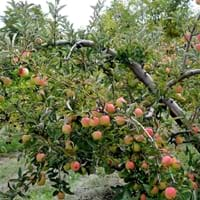Life Span
Perennial
Perennial
Origin
Southeastern United States, North-Central United States, Central United States, South-Central United States, Southwestern United States, Texas, Canada, Mexico
Eastern Europe, Southern Europe, Russia/Siberia, Southern Asia, Western Asia
Types
Not Available
fuji, jonathan apple
Habitat
Dry areas, Prairies, Rocky areas, rocky outcrops
Cold Regions, gardens
USDA Hardiness Zone
3-10
3-8
Sunset Zone
A1, A2, A3, H1, H2, 1a, 1b, 2a, 2b, 3a, 3b, 4, 5, 6, 7, 8, 9, 10, 11, 12, 13, 14, 15, 16, 17, 18, 19, 20, 21, 22, 23, 24
1a, 1b, 2a, 2b, 3a, 3b, 6, 7, 14, 15, 16
Habit
Upright/Erect
Oval or Rounded
Flower Color
Yellow, Purple, Burgundy, Light Green, Brown
White, Pink
Flower Color Modifier
Bicolor
Bicolor
Fruit Color
Brown
Red, Yellow green
Leaf Color in Spring
Light Green, Gray Green
Green
Leaf Color in Summer
Light Green, Gray Green
Green
Leaf Color in Fall
Light Green, Gray Green
Green, Light Yellow, Brown
Leaf Color in Winter
Light Green
Light Green
Leaf Shape
Subulate
Oval Cordate
Plant Season
Summer
Spring, Fall
Sunlight
Full Sun
Full Sun, Partial Sun, Partial shade
Type of Soil
Loam, Sand
Clay, Loam, Sand
The pH of Soil
Neutral
Acidic, Neutral
Soil Drainage
Well drained
Well drained
Bloom Time
Late Spring, Early Summer, Summer, Late Summer
Early Spring, Spring
Tolerances
Drought
Drought
Where to Plant?
Ground
Ground
How to Plant?
Seedlings
Grafting, Seedlings, Stem Planting
Plant Maintenance
Medium
Medium
Watering Requirements
Average Water Needs, Water in morning to avoid prompting diseases
Do not water frequently
In Summer
Lots of watering
Lots of watering
In Spring
Moderate
Moderate
In Winter
Average Water
Average Water
Soil pH
Neutral
Acidic, Neutral
Soil Type
Loam, Sand
Clay, Loam, Sand
Soil Drainage Capacity
Well drained
Well drained
Sun Exposure
Full Sun
Full Sun, Partial Sun, Partial shade
Pruning
Cut or pinch the stems, Pinch Tips, Remove damaged leaves, Remove dead branches, Remove dead flowers, Remove dead leaves, Remove dead or diseased plant parts, Remove deadheads
Prune central stem, Remove lateral branches
Fertilizers
All-Purpose Liquid Fertilizer, Apply N-P-K
Apply 10-10-10 amount, fertilize in growing season, Fertilize the soil before planting
Pests and Diseases
Pests and diseases free, Red blotch
Bacterial Blight, Bacterial Canker, Leaf rust, Red blotch, Ring Rot, Woodpecker feeding
Plant Tolerance
Drought, Dry Conditions, Dry soil, Full Sun
Drought
Flower Petal Number
Single
Single
Foliage Texture
Fine
Medium
Foliage Sheen
Matte
Matte
Attracts
Birds, Butterflies
Bees, Butterflies, Hummingbirds, Insects
Allergy
Rhinitis
Peripheral Edema, Vomiting
Aesthetic Uses
Borders
Cottage Garden, Showy Purposes
Beauty Benefits
Not Available
Acne, For treating wrinkles, Improve skin tone, Moisturizing, Stops hair loss
Environmental Uses
Air purification
Food for animals, Shadow Tree, soil stabilisation, Windbreak
Medicinal Uses
Analgesic
Acne, Alzheimer’s Disease, Anemia, constipation, Gastrointestinal disorders, Hair Loss, Parkinson
Part of Plant Used
Flowers
Fruits
Other Uses
Can be made into a herbal tea, Used in making tea
Acts as a natural source of rain water for birds and insects., Cosmetics, Used As Food
Used As Indoor Plant
No
No
Used As Outdoor Plant
Yes
Yes
Garden Design
Container, Cutflower, Mixed Border, Wildflower
Edible, Fruit / Fruit Tree
Botanical Name
RATIBIDA columnifera
MALUS domestica 'Northern Spy'
Common Name
Mexican Hat
Apple, Cider Apple, Cooking Apple, Eating Apple, Northern Spy Apple
In Hindi
Mexican Hat
Northern Spy Apple
In German
Mexican Hat
Northern Spy Apfel
In French
Mexican Hat
Northern Spy Pomme
In Spanish
mexican Hat
Espía del Norte de Apple
In Greek
Mexican Hat
Βόρεια κατάσκοπος της Apple
In Portuguese
Mexican Hat
Northern Spy a Apple
In Polish
Mexican Hat
Northern Spy Jabłko
In Latin
Mexicanus Hat
Northern Spy Apple
Phylum
Tracheophyta
Magnoliophyta
Class
Magnoliopsida
Magnoliopsida
Family
Asteraceae
Rosaceae
Clade
Angiosperms, Asterids, Eudicots
Dicotyledonous, Rosids
Tribe
Not Available
Not Available
Subfamily
Not Available
Not Available
Number of Species
Not Available
Not Available
Season and Care of Mexican Hat and Northern Spy Apple
Season and care of Mexican Hat and Northern Spy Apple is important to know. While considering everything about Mexican Hat and Northern Spy Apple Care, growing season is an essential factor. Mexican Hat season is Summer and Northern Spy Apple season is Summer. The type of soil for Mexican Hat is Loam, Sand and for Northern Spy Apple is Clay, Loam, Sand while the PH of soil for Mexican Hat is Neutral and for Northern Spy Apple is Acidic, Neutral.
Mexican Hat and Northern Spy Apple Physical Information
Mexican Hat and Northern Spy Apple physical information is very important for comparison. Mexican Hat height is 30.00 cm and width 30.50 cm whereas Northern Spy Apple height is 370.00 cm and width 370.00 cm. The color specification of Mexican Hat and Northern Spy Apple are as follows:
Mexican Hat flower color: Yellow, Purple, Burgundy, Light Green and Brown
Mexican Hat leaf color: Light Green and Gray Green
Northern Spy Apple flower color: White and Pink
- Northern Spy Apple leaf color: Green
Care of Mexican Hat and Northern Spy Apple
Care of Mexican Hat and Northern Spy Apple include pruning, fertilizers, watering etc. Mexican Hat pruning is done Cut or pinch the stems, Pinch Tips, Remove damaged leaves, Remove dead branches, Remove dead flowers, Remove dead leaves, Remove dead or diseased plant parts and Remove deadheads and Northern Spy Apple pruning is done Prune central stem and Remove lateral branches. In summer Mexican Hat needs Lots of watering and in winter, it needs Average Water. Whereas, in summer Northern Spy Apple needs Lots of watering and in winter, it needs Average Water.





